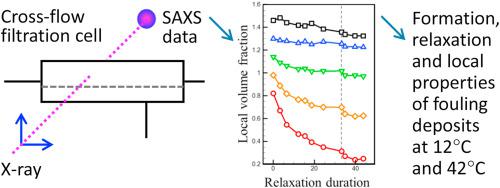当前位置:
X-MOL 学术
›
J. Membr. Sci.
›
论文详情
Our official English website, www.x-mol.net, welcomes your
feedback! (Note: you will need to create a separate account there.)
Build-up and relaxation of membrane fouling deposits produced during crossflow ultrafiltration of casein micelle dispersions at 12 °C and 42 °C probed by in situ SAXS
Journal of Membrane Science ( IF 8.4 ) Pub Date : 2021-01-01 , DOI: 10.1016/j.memsci.2020.118700 Floriane Doudiès , Maksym Loginov , Nicolas Hengl , Mohamed Karrouch , Nadine Leconte , Fabienne Garnier-Lambrouin , Javier Pérez , Frédéric Pignon , Geneviève Gésan-Guiziou
Journal of Membrane Science ( IF 8.4 ) Pub Date : 2021-01-01 , DOI: 10.1016/j.memsci.2020.118700 Floriane Doudiès , Maksym Loginov , Nicolas Hengl , Mohamed Karrouch , Nadine Leconte , Fabienne Garnier-Lambrouin , Javier Pérez , Frédéric Pignon , Geneviève Gésan-Guiziou

|
Abstract Skim milk filtration is performed either at low or high temperature. However, there is still a lack of knowledge concerning the influence of temperature on membrane fouling. We used in situ small-angle X-ray scattering (SAXS) to study external membrane fouling during crossflow ultrafiltration of milk protein (casein micelle) dispersions at 12 °C and 42 °C. Casein micelle concentration distribution was measured in the concentration polarization layer and the deposit in a three-step filtration experiment that consisted of (i) fouling development step (with applied pressure and average cross-flow velocity fixed at 110 kPa and 3.1 cm s−1, respectively), (ii) pressure relaxation step (with pressure reduced to 10 kPa), and (iii) deposit erosion step (with crossflow velocity increased to 15.6 cm s−1). Despite a higher average filtrate flux obtained at 42 °C, filtration at 42 °C resulted in the formation of a thicker and more concentrated deposit than filtration at 12 °C. At both temperatures studied, subsequent pressure relaxation resulted in deposit swelling, which was more intense in the less-compressed external part of the deposit. Deposit swelling rate was significantly higher at 42 °C than at 12 °C. The swelled deposit obtained at 42 °C was more eroded by the crossflow compared to the poorly swelled deposit obtained at 12°. This suggests that deposit formation and compression were more reversible at 42 °C than at 12 °C.
中文翻译:

在 12 °C 和 42 °C 下通过原位 SAXS 探测酪蛋白胶束分散体的错流超滤过程中产生的膜污染沉积物的积聚和松弛
摘要 脱脂牛奶过滤在低温或高温下进行。然而,关于温度对膜污染的影响仍然缺乏知识。我们使用原位小角 X 射线散射 (SAXS) 来研究在 12 °C 和 42 °C 下对牛奶蛋白(酪蛋白胶束)分散体进行错流超滤过程中的外部膜污染。在浓差极化层和沉积物中测量酪蛋白胶束浓度分布,包括 (i) 污垢发展步骤(施加压力和平均错流速度固定在 110 kPa 和 3.1 cm s-1 , (ii) 压力松弛步骤(压力降低到 10 kPa),和(iii)沉积侵蚀步骤(错流速度增加到 15.6 cm s-1)。尽管在 42 °C 下获得了更高的平均滤液通量,但在 42 °C 下过滤会导致形成比在 12 °C 下过滤更厚、更浓缩的沉积物。在所研究的两个温度下,随后的压力松弛导致沉积物膨胀,在沉积物受压较小的外部部分膨胀更为剧烈。沉积物溶胀率在 42°C 时明显高于 12°C。与在 12°C 获得的膨胀较差的沉积物相比,在 42°C 获得的膨胀沉积物更容易被横流侵蚀。这表明沉积物的形成和压缩在 42°C 下比在 12°C 下更可逆。这在沉积物压缩较少的外部部分更为强烈。沉积物溶胀率在 42°C 时明显高于 12°C。与在 12°C 获得的膨胀较差的沉积物相比,在 42°C 获得的膨胀沉积物更容易被横流侵蚀。这表明沉积物的形成和压缩在 42°C 下比在 12°C 下更可逆。这在沉积物压缩较少的外部部分更为强烈。沉积物溶胀率在 42°C 时明显高于 12°C。与在 12°C 获得的膨胀较差的沉积物相比,在 42°C 获得的膨胀沉积物更容易被横流侵蚀。这表明沉积物的形成和压缩在 42°C 下比在 12°C 下更可逆。
更新日期:2021-01-01
中文翻译:

在 12 °C 和 42 °C 下通过原位 SAXS 探测酪蛋白胶束分散体的错流超滤过程中产生的膜污染沉积物的积聚和松弛
摘要 脱脂牛奶过滤在低温或高温下进行。然而,关于温度对膜污染的影响仍然缺乏知识。我们使用原位小角 X 射线散射 (SAXS) 来研究在 12 °C 和 42 °C 下对牛奶蛋白(酪蛋白胶束)分散体进行错流超滤过程中的外部膜污染。在浓差极化层和沉积物中测量酪蛋白胶束浓度分布,包括 (i) 污垢发展步骤(施加压力和平均错流速度固定在 110 kPa 和 3.1 cm s-1 , (ii) 压力松弛步骤(压力降低到 10 kPa),和(iii)沉积侵蚀步骤(错流速度增加到 15.6 cm s-1)。尽管在 42 °C 下获得了更高的平均滤液通量,但在 42 °C 下过滤会导致形成比在 12 °C 下过滤更厚、更浓缩的沉积物。在所研究的两个温度下,随后的压力松弛导致沉积物膨胀,在沉积物受压较小的外部部分膨胀更为剧烈。沉积物溶胀率在 42°C 时明显高于 12°C。与在 12°C 获得的膨胀较差的沉积物相比,在 42°C 获得的膨胀沉积物更容易被横流侵蚀。这表明沉积物的形成和压缩在 42°C 下比在 12°C 下更可逆。这在沉积物压缩较少的外部部分更为强烈。沉积物溶胀率在 42°C 时明显高于 12°C。与在 12°C 获得的膨胀较差的沉积物相比,在 42°C 获得的膨胀沉积物更容易被横流侵蚀。这表明沉积物的形成和压缩在 42°C 下比在 12°C 下更可逆。这在沉积物压缩较少的外部部分更为强烈。沉积物溶胀率在 42°C 时明显高于 12°C。与在 12°C 获得的膨胀较差的沉积物相比,在 42°C 获得的膨胀沉积物更容易被横流侵蚀。这表明沉积物的形成和压缩在 42°C 下比在 12°C 下更可逆。











































 京公网安备 11010802027423号
京公网安备 11010802027423号